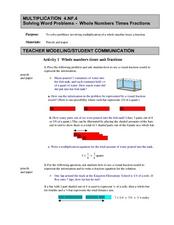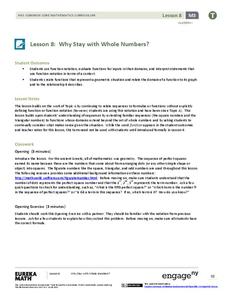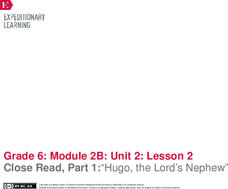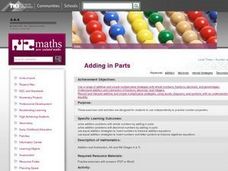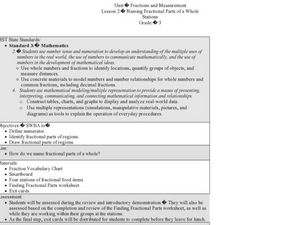EngageNY
Part of a Whole as a Percent
Pupils use visual models, numeric methods, and equations to solve percent problems. To complete the second installment of 20, they find the part given the percent and the whole, find the percent given the part and the whole, and find the...
Fraction Bars
Solving Word Problems - Whole Numbers Times Fractions
An impressive instructional activity where pupils visualize models and solve problems involving multiplying a whole number times a fraction. Fraction bars are used to help learners truly understand what's happening during this...
Fraction Bars
Quotients of Whole Numbers that Equal Fractions
A complete lesson on dividing whole numbers by other whole numbers and getting a fraction result. Groups of learners use fractions bars, and strips of paper that are cut to specific lengths. The hands-on activities in the lesson are...
Digital Forsyth
Parts of a Whole
High school artists create a collaborative piece based on a historical image. Each member of the class is given two days to draw one part of the whole image, when the two days are up; they put their pieces together and discuss the...
EngageNY
Interpreting Division of a Whole Number by a Fraction—Visual Models
Connect division with multiplication through the use of models. Groups solve problems involving the division of a whole number by a fraction using models. The groups share their methods along with the corresponding division and...
Illustrative Mathematics
How Many Servings of Oatmeal?
Here is another way to illustrate division of a whole number by a unit fraction. In this case, the problem is asking if there are so many servings per cup, how many servings are in a package of multiple cups. Learners are to model their...
EngageNY
Why Stay with Whole Numbers?
Domain can be a tricky topic, especially when you relate it to context, but here is a instructional activity that provides concrete examples of discrete situations and those that are continuous. It also addresses where the input values...
Illustrative Mathematics
Cooking with the Whole Cup
Whoops! Travis accidentally put too much butter into the recipe. Your bakers must find out how to alter the recipe to accommodate different changes by using unit rates and ratios . The activity has multiple parts and calculations with...
Turabian Teacher Collaborative
Parts of Argument II: Article Critique
Break down the parts of argumentative writing with a critical thinking activity. High schoolers read an article of your (or their choice), and use a graphic organizer to delineate the ways the author structures his or her arguments.
EngageNY
Construct an Equilateral Triangle (part 1)
Drawing circles isn't the only thing compasses are good for. In this first installment of a 36-part series, high schoolers learn how to draw equilateral triangles by investigating real-world situations, such as finding the location of a...
Teach Engineering
Nanotechnology as a Whole
It's a small (nanotechnology) world after all! The first segment of a six-part series gives an overview of nanotechnology, its principles and applications, and shares some of the engineering applications of nanotechnology. A...
Missouri Department of Elementary
Conflict Mediation – Part 1: Getting Ready
Two scholars walk into a room arguing, what is happening? Peers observe the two actors in preparation for a whole-class discussion about conflict. Learners establish a conflict, name the three approaches—passive, aggressive, and...
Missouri Department of Elementary
Safe and Healthy Life Choices (Part I)
As high schoolers seek to grow more and more independent, they must constantly make choices. Some options are healthy and some not so much. To begin the discussion, class members are asked to identify five safe and healthy (or...
EngageNY
Close Read, Part 1: “Hugo, the Lord’s Nephew”
Fourth time is a charm. Learners complete multiple reads of Hugo, the Lord’s Nephew. On the fourth read, they make notes about each page on sticky notes. They then complete a think-pair-share activity with a partner to determine the...
Curated OER
Adding in Parts
Third graders are able to split whole numbers into parts. They make numbers up to a tidy number. Students add and subtract tenths to make a decimals number into a whole number. They are able to add whole numbers up to three digits.
Community Resources for Science
A Whole New World of DNA and Proteins
Lead your young scientists into an exciting world as they participate in a role play and experiment focused on proteins and DNA. After researching the Central Dogma of Biology, individuals or groups participate in a classroom...
Curated OER
Naming Fractional Parts of a Whole
Third graders complete a worksheet. In this fractions lesson plan, 3rd graders review fraction vocabulary, use the SmartBoard to divide fractions and complete stations where they work with fractional parts of a whole.
Curated OER
Finding Fractional Parts Of A Set
For this finding fractional parts of a set worksheet, learners, working with a partner, problem solve seven word problems and equations involving fractional parts.
Illustrative Mathematics
What’s Missing?
Now you see them, now you don't! This fun peek-a-boo activity engages young mathematicians in developing their ability to compose and decompose numbers. After being presented with a series of counters, children close their eyes while the...
Curated OER
Division by Fractions (Part Two)
Investigate division through the use of array models. The lesson focuses on using area models to compare division as sharing with division as grouping. Students evaluate the usefulness and limitations of the two array models.
EngageNY
Mid-Unit 3 Assessment, Part 2: Explaining How New Information Connects to the Topic
Let's talk it out. Using the resource, scholars work in triads to discuss how their research has deepened their understanding about sustainable fishing. Next, pupils engage in a whole-class discussion to consider their next steps toward...
Curated OER
Fractions: Parts of a Set
Students identify, model, and label simple fractions. They describe and define them as equal parts of a whole, a region and a set. Students use words to describe fractions. They use manipulatives to explore the many different fractions.
Curated OER
Identifying and Using Parts of Speech in Writing: Technology, Word Processing
Students identify and suggest suitable parts of speech to fill in the blanks in a prepared text (the text can easily be tailored to language ability and desired subject). They use word processing to edit the text.
Curated OER
Digital Parts of Speech
Students investigate different parts of speech by creating digital skits. In this digital education lesson plan, students collaborate in groups to research the Internet for clips and music that represent the different parts of speech....
Other popular searches
- Parts and Wholes
- Parts to Wholes
- Fractions Parts and Wholes
- Math Parts and Wholes
- Fractions Parts of Wholes
- Parts and Wholes Science

